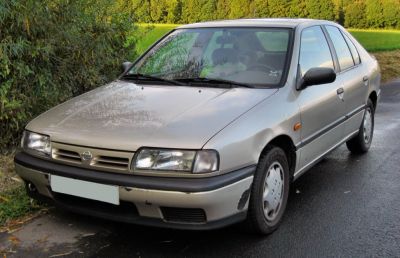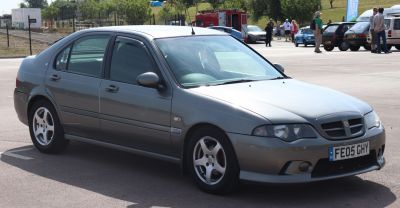 1986 Honda Integra I (DA) 5-door Dimensions, Size & Specs
1986 Honda Integra I (DA) 5-door Dimensions, Size & SpecsMeasurements of the 1986 Honda Integra I 5-door, engineered for optimal performance and comfort
| Dimensions | |
|---|---|
| Length: | 4350 mm171.3 in14.3 ft |
| Width: | 1665 mm65.6 in5.5 ft |
| Height: | 1345 mm53.0 in4.4 ft |
| Ground Clearance: | 165 mm6.5 in0.5 ft |
| Trunk Capacity: | 292 liter10.3 cu ft |
| Trunk Capacity (Max): | 538 liter19.0 cu ft |
| Weight Specifications | |
| Curb Weight: | 945-965 kg2083-2127 lbs |
| Maximal permitted Weight: | 1460 kg3219 lbs |
| Roof Load: | 50 kg110 lbs |
| Tire Specifications | |
| Rims Size: | 13-inch rims:
|
| Tire Size: |
|
The 1986 Honda Integra I (DA) 5-door is a compact hatchback produced between 1985 and 1989. Representing Honda's approach to sporty yet practical vehicles in the mid-1980s, this generation Integra delivers balanced dimensions and efficient use of interior space. Measuring 4350 mm (171.3 inches) in length, 1665 mm (65.6 inches) in width, and standing 1345 mm (52.9 inches) tall, the Integra I offers a compact footprint that fits well within urban environments while still providing ample room for passengers and cargo. Weighing between 945 and 965 kg (2084 to 2127 lbs) when curb-loaded, the hatchback maintains a lightweight profile contributing to its nimble handling and fuel efficiency. Its maximum gross weight stands at 1460 kg (3,216 lbs), supporting versatility for daily driving demands. One of the key practical highlights of the Integra I is its luggage capacity. With the rear seats in place, it offers 292 liters (10.3 cubic feet) of storage space, which expands significantly to 538 liters (19 cubic feet) when the rear seats are folded down, accommodating larger cargo or gear. The vehicle also supports a roof load of up to 50 kg (110 lbs), allowing additional carrying options such as roof racks for bikes or luggage carriers. Ground clearance is measured at a practical 165 mm (6.5 inches), suitable for urban roads as well as moderately uneven surfaces. The Integra I rides on 13-inch rims sized 5J x 13, with tire dimensions of 185/70 R13 that contribute to a comfortable and stable ride quality. Overall, the 1986 Honda Integra I (DA) 5-door stands out as a well-rounded hatchback offering a blend of urban practicality, reasonable cargo capacity, and lightweight construction, making it a desirable option for enthusiasts and everyday drivers alike during its production years.
Discover the standout features that make the 1986 Honda Integra I 5-door a leader in its class
Have a question? Please check our knowledgebase first.
The 1986 Honda Integra I (DA) 5-door hatchback measures 4350 mm (171.3 inches) in length, 1665 mm (65.6 inches) in width, and stands 1345 mm (52.9 inches) tall. These dimensions give it a compact and agile profile suitable for urban driving while maintaining enough interior space for passengers.
The curb weight of the 1986 Honda Integra I (DA) 5-door hatchback ranges between 945 and 965 kilograms (2085 to 2127 pounds). The maximum permissible weight, which includes passengers, luggage, and other cargo, is 1460 kilograms (3219 pounds). This relatively light weight contributes to the car's nimble handling and fuel efficiency.
The Honda Integra I (DA) offers 292 liters (10.3 cubic feet) of luggage space with the rear seats in their upright position, suitable for everyday groceries and small luggage. When the rear seats are folded down, the capacity increases significantly to 538 liters (19 cubic feet), allowing for larger or bulkier items, enhancing the practicality of this hatchback.
The ride height and ground clearance of the Integra I (DA) is 165 mm (6.5 inches). This moderate clearance strikes a balance between sporty handling and everyday usability, enabling it to navigate city streets comfortably while maintaining agility. It is high enough to clear most urban obstacles but low enough to provide stability during cornering and spirited driving.
The 1986 Honda Integra I (DA) is equipped with 5J x 13 inch rims paired with 185/70 R13 tires. These relatively compact wheel and tire dimensions complement the car's lightweight and compact profile, aiding in responsive handling and ride comfort, typical of a sporty hatchback from this era.
Yes, with a length of 4350 mm (171.3 inches), width of 1665 mm (65.6 inches), and height of 1345 mm (52.9 inches), the Integra I (DA) fits comfortably into a standard home garage. Most garages designed for compact and midsize vehicles provide sufficient clearance for parking this model without difficulty, allowing easy maneuverability and storage.
The 1986 Integra I (DA) was the first generation of the Integra model, so it has no direct predecessor within the Integra line itself. However, compared to other compact Hondas of the mid-1980s, it was designed to be slightly larger and more spacious, featuring a 5-door hatchback layout that emphasized practicality. Its innovative packaging offered more interior flexibility compared to earlier Honda compact models, balancing sporty dynamics with everyday usability.
The 1986 Honda Integra I (DA) generally occupies the compact hatchback segment, with dimensions comparable but slightly larger than contemporaries like the Toyota Corolla AE82 hatchback and Nissan Pulsar N13 hatchback. With a length of 4350 mm and 1665 mm width, it offers competitive interior volume and cargo flexibility. The Integra’s slightly lower height of 1345 mm gives it a sportier, sleeker profile compared to some contemporaries, while its ground clearance and lightweight contribute to agile handling.
The maximum roof load capacity of the 1986 Honda Integra I (DA) is 50 kilograms (110 pounds). This means you can safely carry additional luggage or roof-mounted accessories like a roof box or a bike rack within this weight limit. It's important not to exceed this limit to maintain vehicle stability and safety during driving.
The 1986 Integra I (DA) stands out with its combination of sporty design and practical hatchback versatility. Its compact, aerodynamic shape with a 5-door configuration caters to both driving enjoyment and everyday usability. The relatively low curb weight enhances performance, while the foldable rear seats and sizable luggage capacity increase its practicality. It was a pioneering model in Honda’s lineup, balancing fun-to-drive characteristics with functional design for a broad audience.
Discover similar sized cars.

| Production: | 1990-1996 |
|---|---|
| Model Year: | 1990 |
| Length: | 4400 mm173.2 in |
| Width: | 1700 mm66.9 in |
| Height: | 1390 mm54.7 in |

| Production: | 2001-2004 |
|---|---|
| Model Year: | 2002 |
| Length: | 4385-4400 mm172.6-173.2 in |
| Width: | 1695-1725 mm66.7-67.9 in |
| Height: | 1380-1400 mm54.3-55.1 in |

| Production: | 2001-2005 |
|---|---|
| Model Year: | 2001 |
| Length: | 4377 mm172.3 in |
| Width: | 1696 mm66.8 in |
| Height: | 1386 mm54.6 in |
